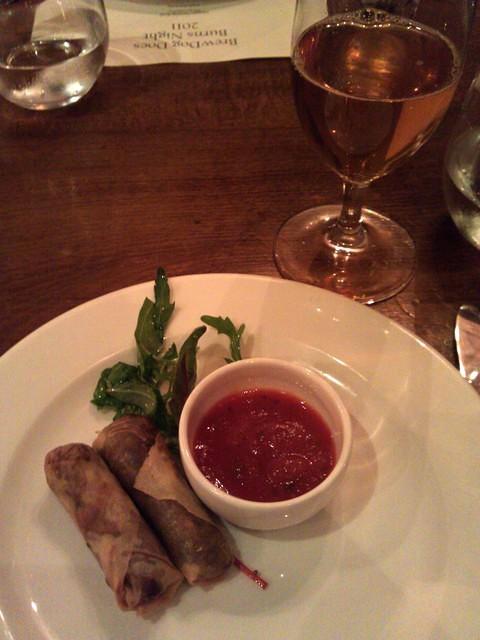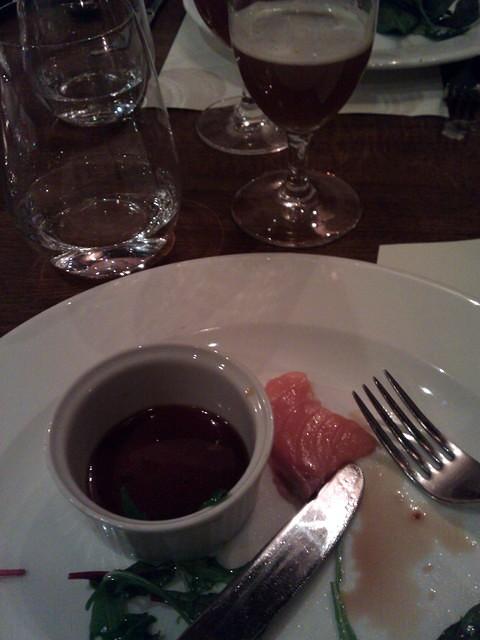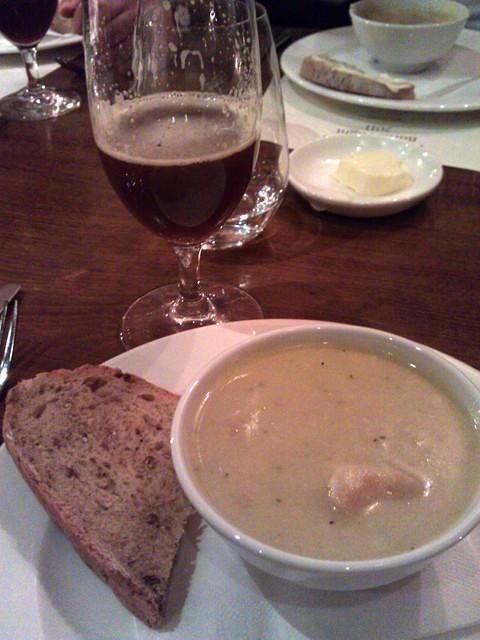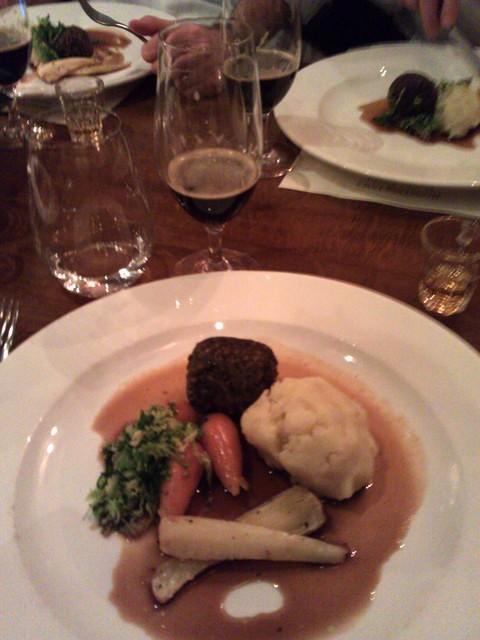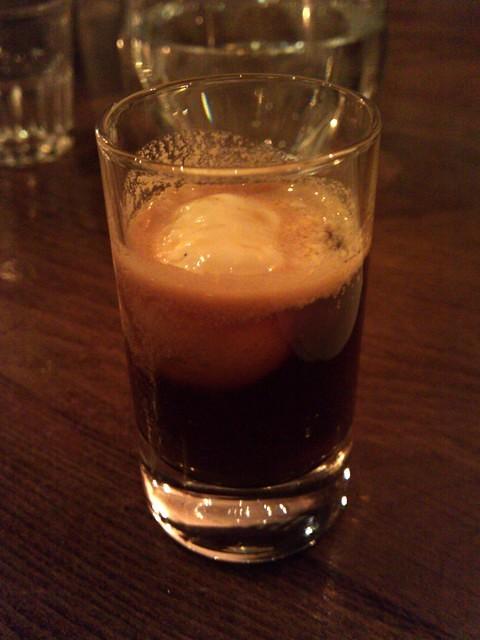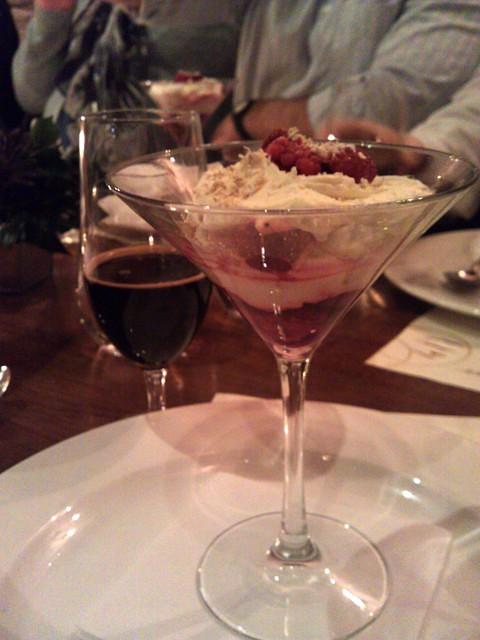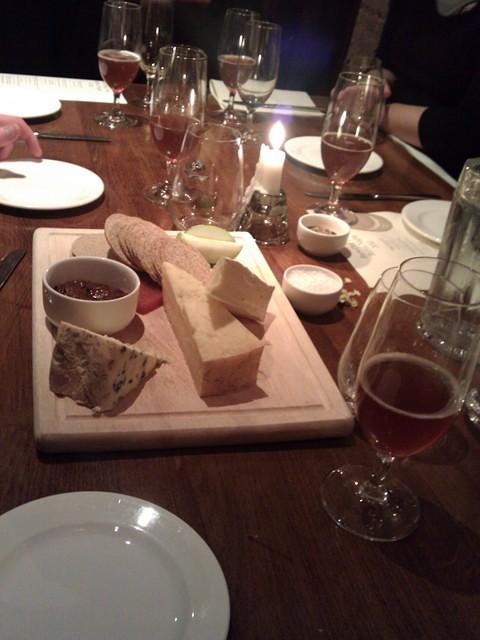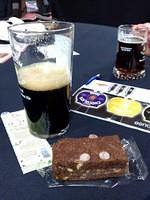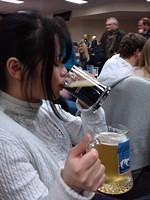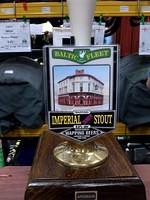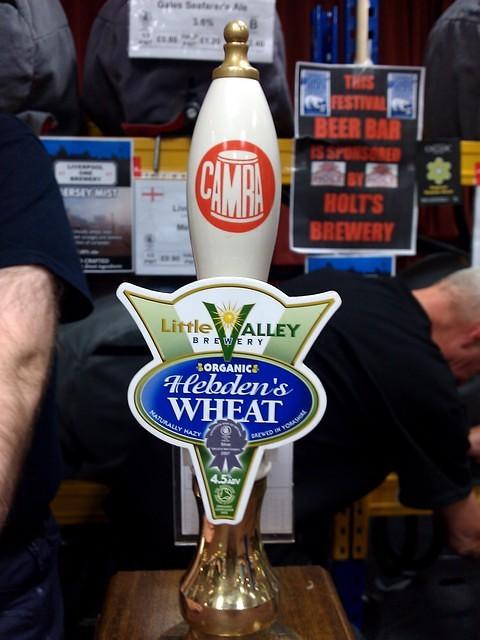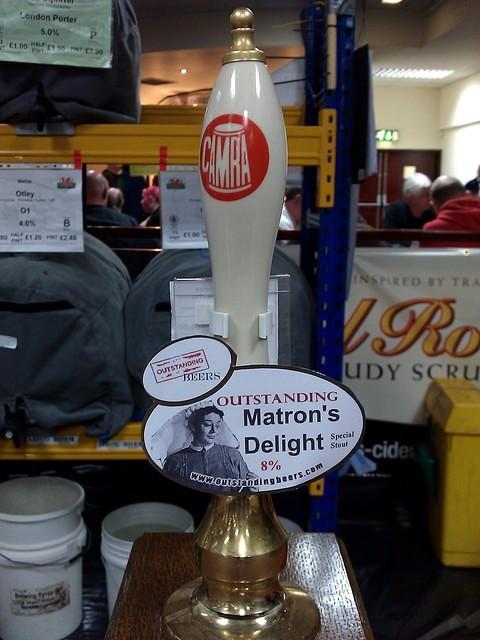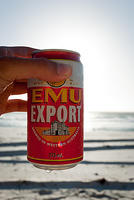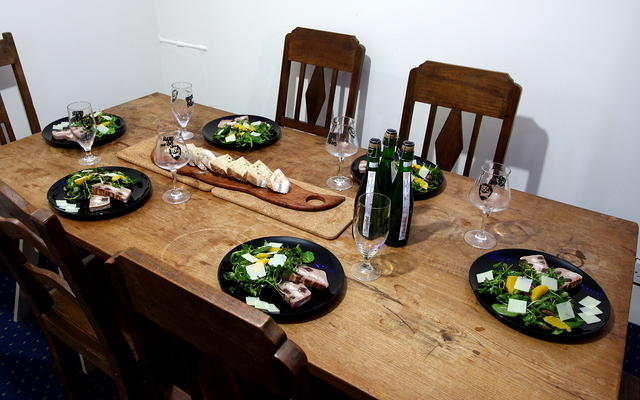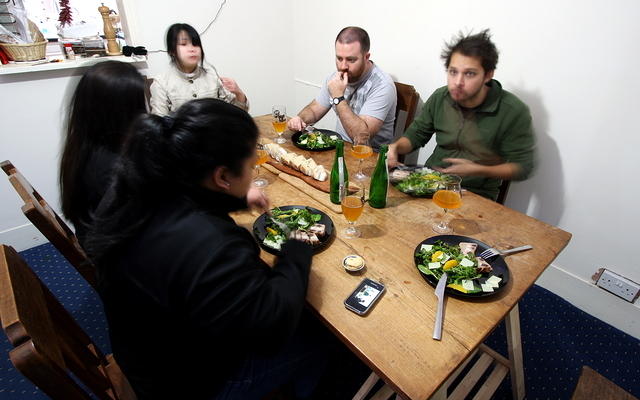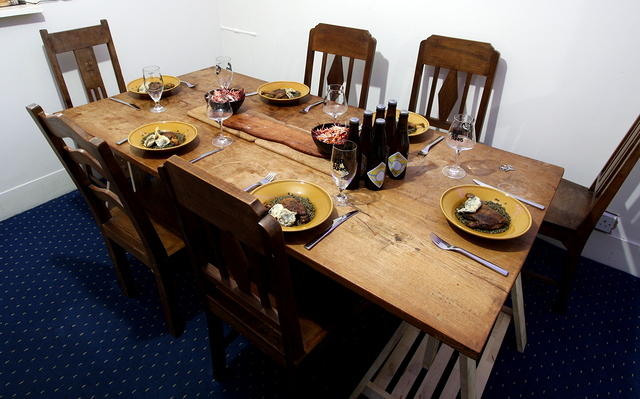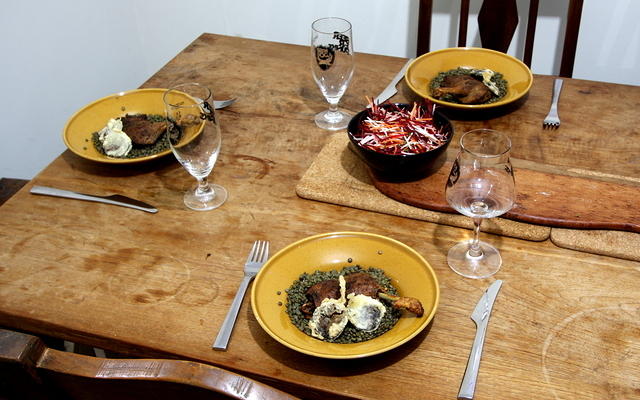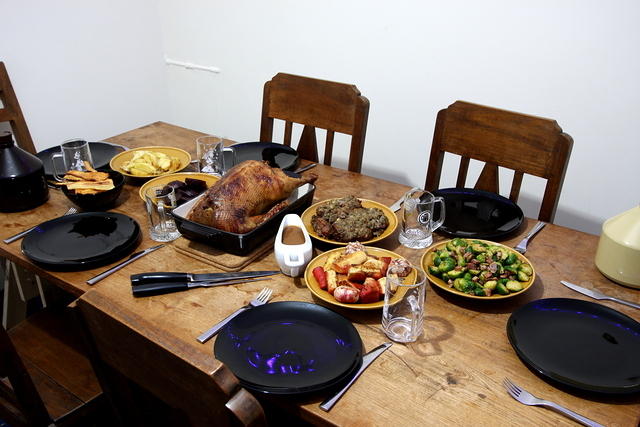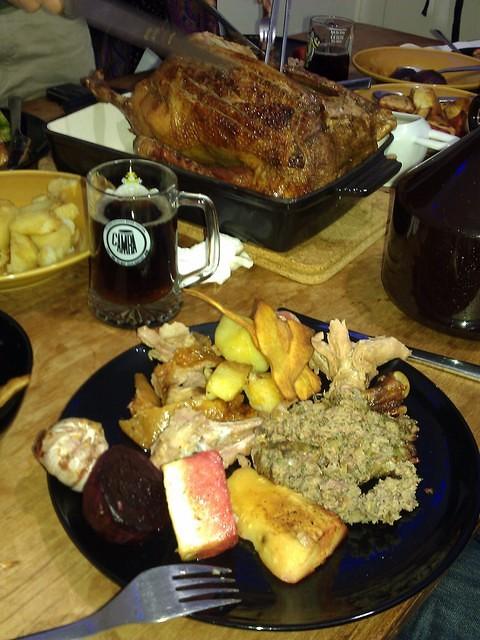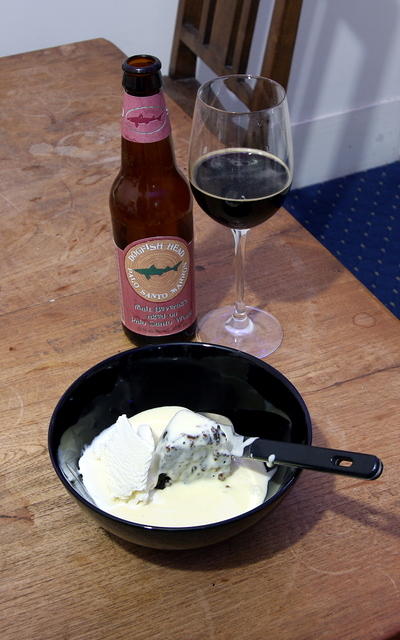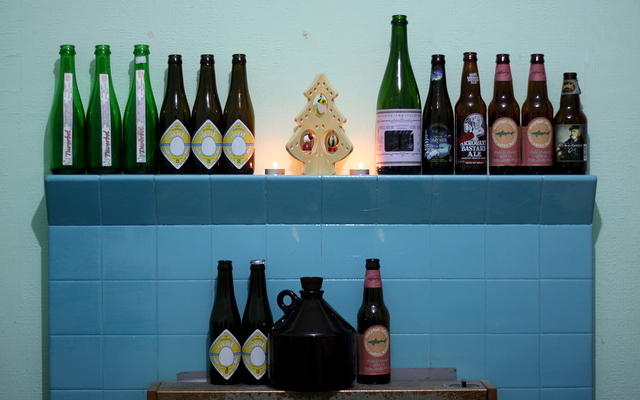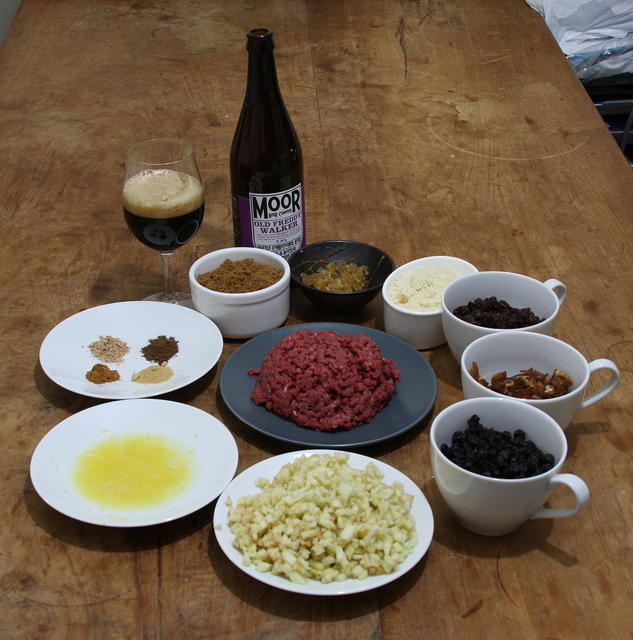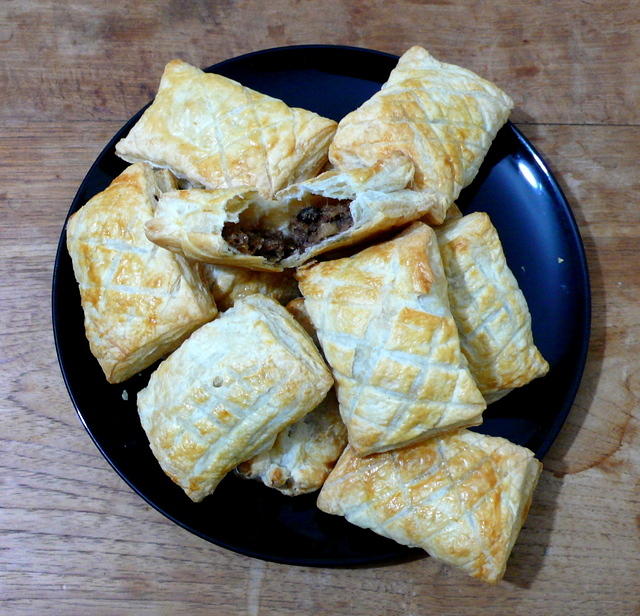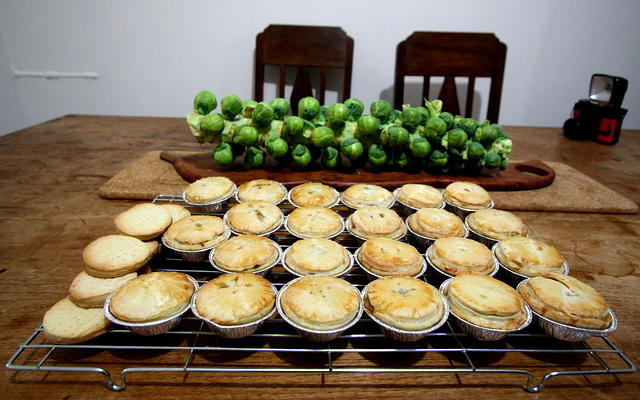Beer and food matching is becoming an ever more popular theme in the craft beer world. I’m all for it and have written about my own attempt at beer matching for Christmas dinner and how that turned out. Recently I’ve been doing more cooking and matching with beer than usual, exploring the possibilities. However, I’d never been to a professionally
prepared beer and food matching dinner. So when the BrewDog Burns Night at the White Horse
in London showed up on the radar I was quite keen to sign up. Unfortunately I left it too late, waiting to see if others wanted to attend, and by the time I
called the White Horse it was fully booked. Onto a waiting list for us! Fortunately they had a big enough waiting list that they put aside another room to accommodate the overflow.
On Burns Night we rocked up to a very busy White Horse just before things kicked off. Enough time for a sneaky half of AlphaDog and 4.1% RipTide. Us
“overflow” people were in the room at the back of the right hand side of the pub. Our hosts were Tom Cadden, London sales manager, and Josie Ludford,
Northern England sales manager. The usual sort of intro was made, explaining BrewDog and the concept of matching beer to food and soon we were into the meal.
Haggis Spring Rolls
With Spicy Chilli Sauce
Punk IPA 5.4%
We’ve had haggis spring rolls twice before, exclusively at Musa Aberdeen, and we enjoyed them so much we’re considering making some. (Kat is quite the spring-roll ninja, though she’d call them haggis lumpia – the Filo name.) The pairing with the new Punk IPA with its hop-punch aroma works well. The Punk might be a bit much for some spring rolls but as haggis is heavily spiced these hold up well.
The new Punk IPA was interesting to try, especially since I’ve done a side-by-side between the “old Punk” and “new Punk”. The Punk IPA served with this beer was a little “less” than the bottled “Punk X” I have. Less cloudy, less biscuity malt aroma and flavour, a bit less hop aroma too I think. This Punk was served
from cask, presumably it had been given time to drop quite clear. There was a slight haze to the beer, probably from hop oils I guess. I think they’ve toned it down a little, finding a balance between the previous Punk IPA and the bottled “Punk X”. Keeping the clear-beer folks happier at the cost of hitting the drinker with a bit less flavour? Or rounding out the beer in the quest for perfection? Anyway, this Punk IPA is still definitely a better beer than the original incarnation in my mind.
Scottish Salmon Sashimi
Pickled Cucumber & Soy Sauce
Hello, my name is Ingrid 8.2%
Ah, sashimi! We used to eat loads back in Sydney and miss it dearly. Unfortunately sashimi (sushi in general) in the UK is crap, and if it isn’t then it is very expensive. The salmon served here was good stuff and I dug in without remembering to take a photo first. Oddly they seem to have left out the pickled cucumber and served this with a bit of mixed leaf salad instead. Ran out perhaps.
The Hello, my name is Ingrid was quite drinkable (we all drunk it quite happily). Though I recall calling it “muddy” and now wish I’d made some more detailed notes about the beers we tried. This beer will not be available in the UK, except for a couple of special events like this one. It was brewed especially and exclusively for BrewDog’s Swedish distributor.
As for the pairing – nothing wrong, but I didn’t feel there was a notable synergy between the beer and the salmon. I’m thinking something simpler would be a better match. Less malt for sure and a clearer crisper beer. Possibly late-hopped with Sorachi Ace, a bit of a play on the Japanese theme and the lemony note fits as a classic combination for fish. (I like dark soy with a squeeze of lemon with my sashimi.) Or, how about something like the Mikkeller “Spontonale”?
Cullen Skink
With Homemade Bread
Bitch Please 10.5%
A sweet and thick potato and onion soup with chunks of smoked fish in it with a big strong barleywine. Seems too much, but it worked. The Bitch Please is a mouthful of flavour, my notes at the time were: “pretty crazy super-malty barleywine cross rich hoppy US super-IPA – late night sipping beer.” This bitch really is crazy, a collaboration between BrewDog and US brewers 3 Floyds, the beer has all sorts in it – not literally, I think. I’m uncertain of the exact details as I keep hearing new stories about it. At the very least there’s toffee and shortbread, as documented on the BrewDog blog.
It’s the IPA side of the beer that makes it work with this food pairing in my mind. Without the big hops the whole meal would probably be a bit over-sweet. I usually find barleywine style beers cloying, and it is probably the hops that transform this beer into something very drinkable.
Haggis with Neeps & Tatties
Roast Winter Vegetables & Mashed Potatoes
Alice Porter 6.2%
(There was also a sneaky nip of Talisker (single malt whisky) served with this.)
To start with we had the full haggis ceremony. Bagpipes, haggis on a platter, recital of Burns’s Address tae the Haggis (not quite so perfectly recited), dousing said haggis in whisky, then eager haggis stabbing. Quite a show.
Alice Porter is an excellent beer, I came upon it in Borough Market’s Market Porter a couple of weeks beforehand and couldn’t stop knocking back pints. (Then I realised it was 6.2% and decided I’d better stop and embark on the hour-long journey home.)
How does it go with haggis though? Just fine, this beer and our haggis were both dark and rich so they stood up well against each other. The pairing seemed to me more a meeting of equals than a complimentary relationship. The beer washed down the haggis perfectly without drowning it or feeling thin.
The big surprise for me was that the Alice Porter also stood its ground against the whisky. In fact the Talisker complimented the Alice rather well… as tempted as I was to tip the whisky into the beer I held back and enjoyed the beer in the warm afterglow of whisky sips.
TNP Float
Vanilla Icecream with Tactical Nuclear Penguin 33%
The Tactical Nuclear Penguin is an unusual beast. I got two bottles of this about a year ago, one of which remains unopened. This TNP was all syrupy burnt flavours and smoke. I loved it. It’s the Smokehead variety of the Paradox Stout (~10%) that’s had a bunch of water frozen out of it. Smokehead itself is a sublime beer, for those of us who like our smoke. To obtain this flavour Smokehead is aged in the used whisky barrels of its namesake, Smokehead whisky – which I’ve had and enjoyed.
There are some further complications however. I have had cask Paradox Smokehead three times, all different. One was rich and smoky, one was thin, astringent, and smoky, and the last rich but barely smoky. On my first visit to the BrewDog brewery I was told by one of their brewers that they were freeze-distilling a batch of Tokyo* for TNP. I tasted a bit of this as it was being drained from a large plastic container and it really did seem like super-concentrated Tokyo* – it was a beautiful thing.
Now, this TNP Float – to my nose – lacked smoke. The aroma was sweet and dark fruity richness. This seemed to me to be Tokyo*, not Smokehead. So I asked one of our hosts about this, the London sales manager, and he was certain it was Smokehead and had never heard of TNP being made from Tokyo*. So where do I stand? Utterly confused!
That digression aside, the “TNP Floater” worked extremely well. Next time we have people over for dinner I’m tempted to give it a shot!
Raspberry Cranachan
Fresh Raspberries, Oats, & Whipped Cream
Black Tokyo Horizon 15%
Just the memory of this dessert makes me close my eyes and lean back. Trying to re-live it.
Cranachan is a most simple pleasure but something I’d not order because it is often just too thick. Not enough fruit, juice, and acidity to fight the cream. This was one of those cranachans. But it was rescued, enlivened, and made most enjoyable by the Black Tokyo Horizon. A spoonful of the dessert, a sip of the beer, repeat. There was an edge to the beer that cut right through the cream, an umami that rounded out the whole dish. This goes right up there with Mum’s rich Grand Marnier chocolate mouse in my dessert hall of fame. Then again, that could be under the influence of strong ale.
Black Tokyo Horizon rocks. My mission is to track down bottles of its constituent ingredients. The BTH is a blend of beers: BrewDog’s Tokyo*, NøgneØ’s Dark Horizon, Mikkeller’s Black. The Tokyo* is what I drink if I feel like port. Seriously round, rich, deep beer. This blend takes that and fills it full of roast dinner and goose fat. Rich, dark plum conserve, toffee pudding, smoked sausage. Smoked sausage!? Yes! There’s a following mouthfeel of bonfire smoke… I love this in a beer.
Scottish Cheese & Oatcakes
Dunsyre Blue, Isle of Mull and Clava Organic Blue Cheese
Hardcore IPA 9.2%
Cheese! A step too far? Never!
I do like my cheese, yet this final course was the one I was most concerned about. I love cheese, especially mouldy cheese. I love US-style strong IPAs, especially BrewDog’s Hardcore IPA. But could these two work together?
Almost… but not entirely. As robust and full-on as the Hardcore IPA is, I think it didn’t stand up to the tasty cheeses. That said, the “Clava Organic Blue Cheese” is, as far as I can determine, a “typo” that should be: “Clava Organic Brie”. (I’d have preferred a blue brie personally.) Amusingly, I think of the cheeses provided the brie was the best compliment to the Hardcore IPA.
It’s not dire however. While I felt the strong cheeses were far bigger than the Hardcore IPA I do believe they whipped it into submission and, with their salty richness, smoothed out the hops character and brought out an almost barleywine side of the IPA.
Wrapping Up
I, Kat, and our 3 invitees, all enjoyed the BrewDog Burns Night at the White Horse. It was a continuing education for our non-beergeek friends, two of whom had survived my Christmas dinner. There’s still some way to go to break the mental barrier separating beer from wine though. Note however that we were all Australians, “back home” the culture of beer is even further separated from dining than it is in the UK.
Personally: I’ve been to a few fancy degustations matched against specific wines and feel that this meal was a better effort than all of them. An important element to the beverage that we call “beer” is that it can provide an incredibly huge variety of flavour dimensions. Wine, in my experience, is more limited. (I’m going to get in trouble if I’m not careful. I grew up in a wine region in Australia and love and appreciate good wine.) The point is that a brewer can sit down and produce a beer with a particular experience in mind, possibly therein lies an interesting future of beer in gourmet circles. In the BrewDog Burns Night experience the feeling was that an excellent range of beer had been chosen then a series of dishes had been arranged around this. I think there is a potential to take a degustation menu and design a range of ales to match. Beer really is that flexible. You don’t have to drop to El Bulli levels and create the Estrella Damm Inedit – a beer so bland it’d go with anything (much like water does).
Long live craft beer! And hail those who can see and appreciate beer for the versatile medium of multidimensional flavour that it is.
